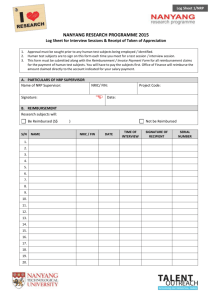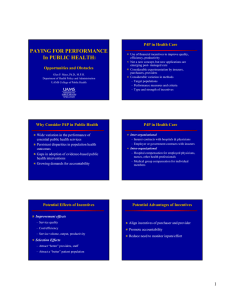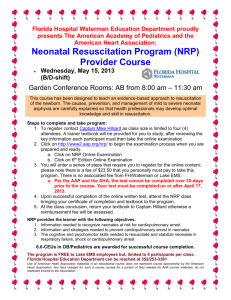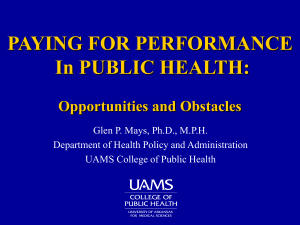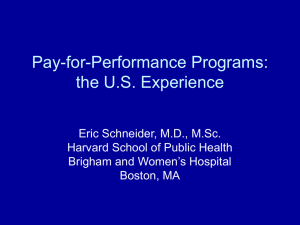FOCUSING ON HEALTH REFORM RAND Research on Pay for Performance
advertisement
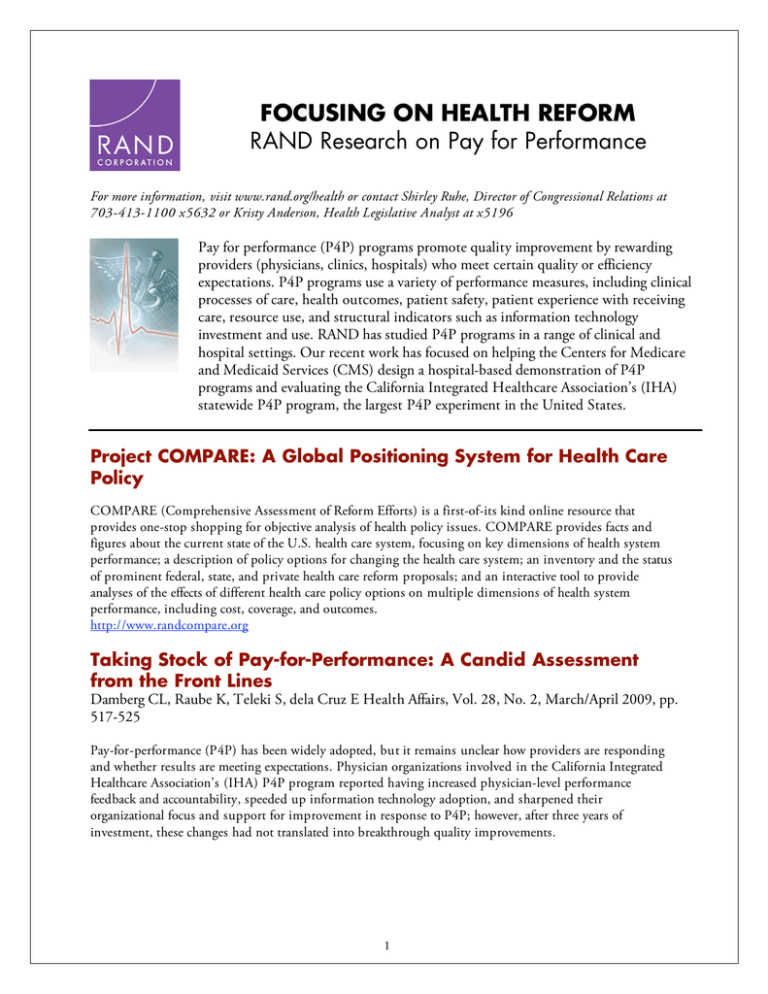
FOCUSING ON HEALTH REFORM RAND Research on Pay for Performance For more information, visit www.rand.org/health or contact Shirley Ruhe, Director of Congressional Relations at 703-413-1100 x5632 or Kristy Anderson, Health Legislative Analyst at x5196 Pay for performance (P4P) programs promote quality improvement by rewarding providers (physicians, clinics, hospitals) who meet certain quality or efficiency expectations. P4P programs use a variety of performance measures, including clinical processes of care, health outcomes, patient safety, patient experience with receiving care, resource use, and structural indicators such as information technology investment and use. RAND has studied P4P programs in a range of clinical and hospital settings. Our recent work has focused on helping the Centers for Medicare and Medicaid Services (CMS) design a hospital-based demonstration of P4P programs and evaluating the California Integrated Healthcare Association’s (IHA) statewide P4P program, the largest P4P experiment in the United States. Project COMPARE: A Global Positioning System for Health Care Policy COMPARE (Comprehensive Assessment of Reform Efforts) is a first-of-its kind online resource that provides one-stop shopping for objective analysis of health policy issues. COMPARE provides facts and figures about the current state of the U.S. health care system, focusing on key dimensions of health system performance; a description of policy options for changing the health care system; an inventory and the status of prominent federal, state, and private health care reform proposals; and an interactive tool to provide analyses of the effects of different health care policy options on multiple dimensions of health system performance, including cost, coverage, and outcomes. http://www.randcompare.org Taking Stock of Pay-for-Performance: A Candid Assessment from the Front Lines Damberg CL, Raube K, Teleki S, dela Cruz E Health Affairs, Vol. 28, No. 2, March/April 2009, pp. 517-525 Pay-for-performance (P4P) has been widely adopted, but it remains unclear how providers are responding and whether results are meeting expectations. Physician organizations involved in the California Integrated Healthcare Association’s (IHA) P4P program reported having increased physician-level performance feedback and accountability, speeded up information technology adoption, and sharpened their organizational focus and support for improvement in response to P4P; however, after three years of investment, these changes had not translated into breakthrough quality improvements. 1 Pay for Performance in the Hospital Setting: What Is the State of the Evidence? Mehrotra A, Damberg CL, Sorbero MES, Teleki SS American Journal of Medical Quality, [Epub Dec 10 2008], Vol. 24, No. 1, Jan/Feb 2009, pp. 19-23 The few evaluations of hospital P4P to date have for the most part shown positive but small improvement effects. There is an urgent need for more systematic evaluation of hospital P4P to understand its effect and whether the benefits of investing in P4P outweigh the associated costs. The Response of Physician Groups to Pay-for-Performance Incentives Mehrotra A, Pearson SD, Coltin KL, Kleinman KP, Singer JA, Rabson B, Schneider EC. American Journal of Managed Care, Vol. 13, No. 5, May 2007, pp. 249-255 P4P incentives are now common among physician groups in Massachusetts, and these incentives most commonly reward higher clinical quality or lower utilization of care. Although the scope and magnitude of incentives are still modest for many groups, we found an association between P4P incentives and the use of quality improvement initiatives. Will Financial Incentives Stimulate Quality Improvement? Reactions from Frontline Physicians Teleki SS, Damberg CL, Pham C, Berry SH. American Journal of Medical Quality, Vol. 21, No. 6, Nov/Dec 2006, pp. 367-374 Physicians believe that they play a significant role and have a moderate to high degree of control over quality of care and that it is important to self-monitor. Physicians expressed the need for accurate and timely data, peer comparisons, and more patient time, staff support, and consultations with colleagues to successfully monitor and deliver quality care. Many support increased pay for delivering high-quality care but question measurement accuracy, bonus payment financing, and health plan involvement. Accuracy of Hospital Report Cards Based on Administrative Data Glance LG, Dick AW, Osler TM, Mukamel DB. Health Services Research, Vol. 41, No. 4, Aug 2006, pp. 1413-1437 This study supports the hypothesis that the use of routine administrative data without date stamp information to construct hospital quality report cards may result in the misidentification of hospital quality outliers. 2 Pay for Performance: Its Influence on the Use of IT in Physician Organizations Williams TR, Raube K, Damberg CL, Mardon RE. Journal of Medical Practice Management, MarApr 2006, pp. 301-305 In this article, the authors describe what may be the nation’s largest pay-for-performance program, its performance metrics, and incentives for the implementation and use of IT in medical groups and independent physician associations (IPAs). Results include the increased use of electronic clinical data, point-of-care technology, and the generation of more actionable reports for quality improvement. Noteworthy are the efforts by physician organizations to enhance data collection to demonstrate improved clinical performance and earn financial incentives. Paying for Performance: Implementing a Statewide Project in California Damberg CL, Raube K, Williams T, Shortell SM. Quality Management in Health Care, Vol. 14, No. 2, Apr/Jun 2005, pp. 66-79 In 2002, the Robert Wood Johnson Foundation (RWJ) and the California HealthCare Foundation (CHCF) funded seven demonstration projects under the Rewarding Results program to implement and evaluate financial and non-financial incentives for quality. The largest is the Integrated Healthcare Association's (IHA) Pay for Performance (P4P) program, which currently covers over 6.5 million Californians. This article describes the implementation of the IHA P4P program and explores the difficult decisions and collaborative structures that were created to make statewide P4P a reality in California. The Office of Congressional Relations provides any of the listed documents to Congressional offices and U.S. Federal agencies on request, at no charge. Updated 6/15/09 3
